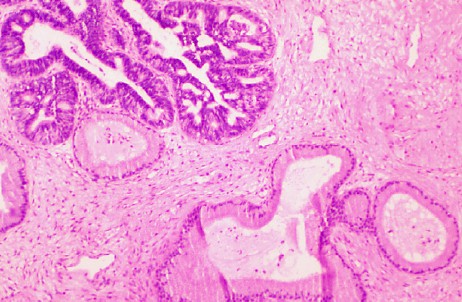
Adenocarcinoma in situ of the cervix
(upper left), next to normal glandular epithelium (lower right). |
Glandular cells are normally found in the endocervical
canal and endometriuim.
While most cancer of the cervix derives from squamous
cells (skin cells of the cervix), a few cases derive from the glandular
cells that line the endocervical canal.
The presence of atypical glandular cells on a Pap smear
is clinically troubling: This finding may indicate:
-
Endometrial cancer, or its precursors
-
Adenocardinoma of the endocervix, or its precursors
-
Squamous cell cancer of the cervix, or its precursors
-
A normal patient.
For this reason, a careful workup of the patient is
usually indicated, including colposcopy, directed cervical biopsies,
endocervical sampling and repeat cytology. Endometrial biopsy should be
performed in women over age 35, women with abnormal bleeding, and women
whose atypical glandular cells are endometrial in appearance.
Abnormalities identified through these techniques are managed in the
usual way. Should no abnormality be found during this
workup, high-risk patients (those with AIS or AGC-Favor Neoplasia) on
Pap smear will usually need an excisional biopsy of the cervix. Most
favor a cold knife conization for this, but a LEEP procedure could be
acceptable in selected patients. Long term followup would
include frequent (every 4-6 months) Pap smears until four consecutive
negative results are obtained. |